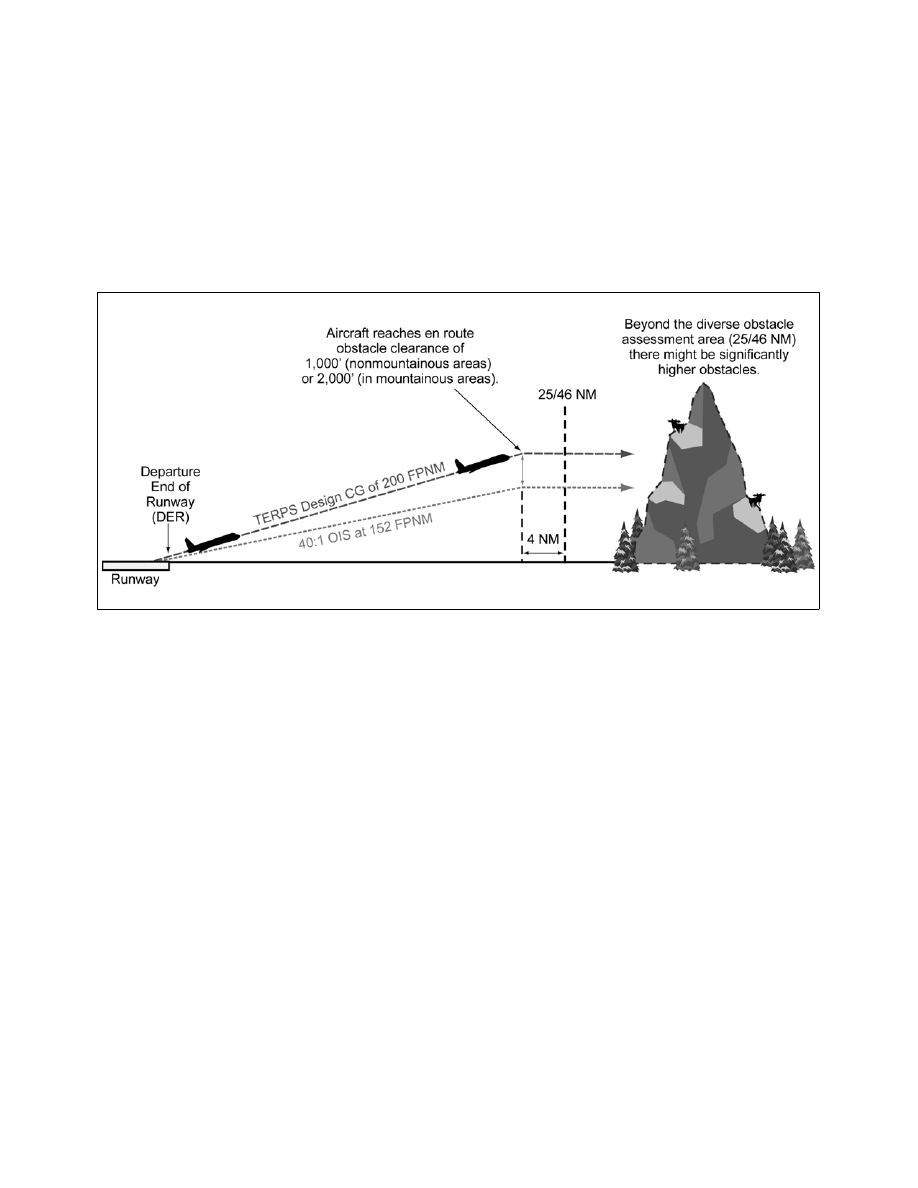
AIM
4/3/14
5−2−7
Departure Procedures
ture. This assessment area is limited to 25 NM from
the airport in nonmountainous areas and 46 NM in
designated mountainous areas. Beyond this distance,
the pilot is responsible for obstacle clearance if not
operating on a published route, if below (having not
reached) the MEA or MOCA of a published route, or
an ATC assigned altitude. See FIG 5−2−1. (Ref 14
CFR 91.177 for further information on en route alti-
tudes.)
NOTE
−
ODPs are normally designed to terminate within these dis-
tance limitations, however, some ODPs will contain routes
that may exceed 25/46 NM; these routes will ensure
obstacle protection until reaching the end of the ODP.
FIG 5
−2−1
Diverse Departure Obstacle Assessment to 25/46 NM
4.
Obstacles that are located within 1 NM of the
DER and penetrate the 40:1 OCS are referred to as
“low, close−in obstacles.” The standard required
obstacle clearance (ROC) of 48 feet per NM to clear
these obstacles would require a climb gradient greater
than 200 feet per NM for a very short distance, only
until the aircraft was 200 feet above the DER. To
eliminate publishing an excessive climb gradient, the
obstacle AGL/MSL height and location relative to the
DER is noted in the “Take−off Minimums and
(OBSTACLE) Departure Procedures” section of a
given Terminal Procedures Publication (TPP) book-
let. The purpose of this note is to identify the
obstacle(s) and alert the pilot to the height and loca-
tion of the obstacle(s) so they can be avoided. This
can be accomplished in a variety of ways, e.g., the
pilot may be able to see the obstruction and maneuver
around the obstacle(s) if necessary; early liftoff/climb
performance may allow the aircraft to cross well
above the obstacle(s); or if the obstacle(s) cannot be
visually acquired during departure, preflight plan-
ning should take into account what turns or other
maneuver may be necessary immediately after
takeoff to avoid the obstruction(s).
5.
Climb gradients greater than 200 FPNM are
specified when required to support procedure design
constraints, obstacle clearance, and/or airspace re-
strictions. Compliance with a climb gradient for these
purposes is mandatory when the procedure is part of
the ATC clearance, unless increased takeoff minim-
ums are provided and weather conditions allow
compliance with these minimums. Additionally, ATC
required crossing restrictions may also require climb
gradients greater than 200 FPNM. These climb gradi-
ents may be amended or canceled at ATC’s discretion.
Multiple ATC climb gradients are permitted. An ATC
climb gradient will not be used on an ODP.
EXAMPLE
−
“Cross ALPHA intersection at or below 4000; maintain
6000.” The pilot climbs at least 200 FPNM to 6000. If 4000
is reached before ALPHA, the pilot levels off at 4000 until
passing ALPHA; then immediately resumes at least 200
FPNM climb.
EXAMPLE
−
“TAKEOFF MINIMUMS: RWY 27, Standard with a min-
imum climb of 280’ per NM to 2500, ATC climb of 310’ per
NM to 4000 ft.” A climb of at least 280 FPNM is required
to 2500 and is mandatory when the departure procedure is